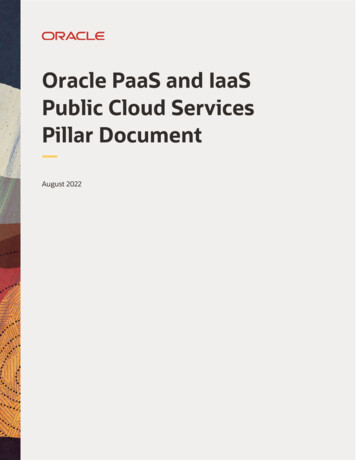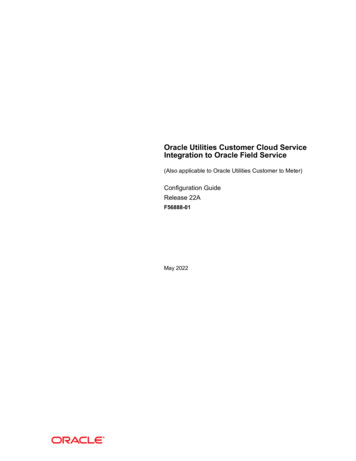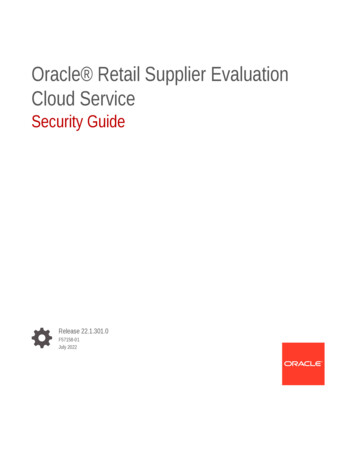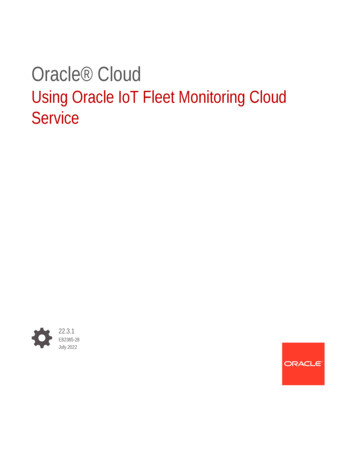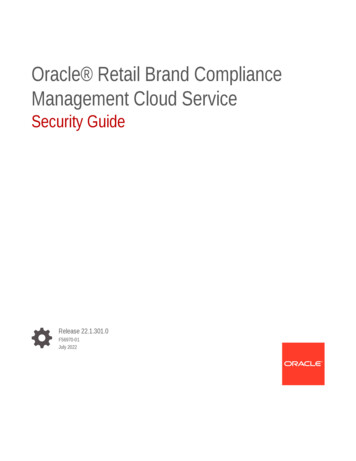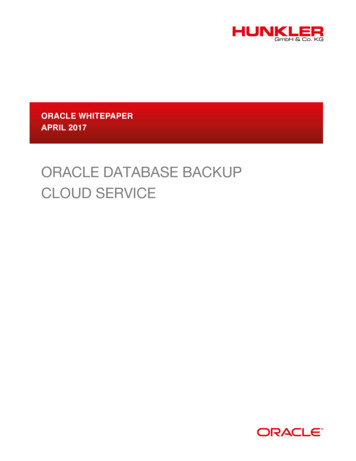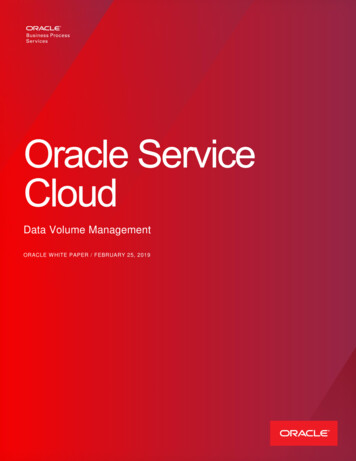
Transcription
Oracle ServiceCloudData Volume ManagementORACLE W HITE PAPER / FEBRUARY 25, 2019
Table of ContentsIntroduction . 4Intended Audience . 4Oracle service Cloud Platform – Data Volume Management. 4Why data volume management is crucial . 4DB tables of interest . 4Monitoring Database Usage . 5Oracle Cloud Portal . 5Configuration Assistant . 5Data Volume Management . 7Data Lifecycle Management (DLM) . 7Using configuration verbs to define purge policies . 9Bulk Delete API .10Using custom objects for logging .11Why are large database reductions not being seen? .12High volume tables vs. course of action .12File Attachment Server (FAS) volume management. 14Best Practices . 14Conclusion . 152W HITE PAPER / Oracle Service Cloud: Data Volume Management
Additional Resources . 153W HITE PAPER / Oracle Service Cloud: Data Volume Management
INTRODUCTIONThis whitepaper provides an insight into various data volume managementcapabilities offered by Oracle Service Cloud. This allows customers toefficiently manage data storage on their site and meet their organizationalcompliance policies.INTENDED AUDIENCEThis whitepaper is a useful read for all Oracle Service Cloud administrators, partners, technicalconsultants and Customer Success Managers (CSMs).ORACLE SERVICE CLOUD PLATFORM – DATA VOLUME MANAGEMENTOracle Service Cloud enables organizations to deliver great customer experiences through variouschannels including email, co-browse, telephony, live chat and other social channels.Why data volume management is crucialOracle Service Cloud database is a transactional system storing all interactions processed fromcustomers, agents and end-users. The backend database is designed and optimized to processindividual transactions efficiently and is not intended to be used for long-term trending and reportingneeds. Hence it is critical to keep the database size in check for the product to be highly performant andagile. An optimized and healthy database offers various benefits like easier and faster updates, fasterreport execution, faster database cloning, faster recovery from catastrophic failure and an overallimproved performance. In short, efficient data management in Oracle Service Cloud helps you providea greater customer experience that your customers deserve.In most cases, the primary reason for the excessive database growth is due to retention of historicaldata in the database, which will in turn have negative consequences on your Service Cloud site’sperformance. It is critical that data management policies be set up to clean historical data and keep aconsistent database size either by deleting them from the database or by moving it to a data warehousefor longer-term reporting and trending needs. Some downsides of historical data retention in ServiceCloud include potentially significant performance impact for both customers and agents, increasedoperational costs, reports taking longer time to run, failures in updates because replication is fallingbehind, utilities taking longer time to run and database clones taking longer time to complete.It is important to note that the larger the database size, the more time it takes to complete all the crucialdata operations. Hence, an appropriate set of data volume management policies are key to maximizeOracle Service Cloud success.DB tables of interestWe often notice some of the following tables could grow large very quickly: incidents threads phrases4W HITE PAPER / Oracle Service Cloud: Data Volume Management
transactions user trans co trans inc performance papi meters/papi method meters clickstreams contacts archived incidents custom objects PS logOracle Service Cloud provides tools and mechanisms to help you establish a data volume managementstrategy that we will cover in detail in the subsequent sections.MONITORING DATABASE USAGEThe first and foremost step for efficient data volume management is to know what your current databaseusage is. “What makes up the size of my site and database” is one of the most frequently askedquestions by the Service Cloud customers. Following data monitoring tools will help you to pro-activelymonitor the database storage size and usage of your Oracle Service Cloud site: Oracle Cloud Portal Configuration AssistantOracle Cloud portal can be used to view the overall database usage of your Service Cloud site whileConfiguration Assistant can be used to view the table-level database usage.Oracle Cloud PortalOracle Cloud Portal (cloud.oracle.com) houses self-service tools that Oracle Service Cloud customerscan use to manage their sites and instances. You can use Cloud Portal to view and monitor the resourceutilization and database usage for your Oracle Service Cloud site, among other things.To access the cloud portal, launch https://cloud.oracle.com/homeAdditional information on using the Oracle Cloud Portal can be found at:http://docs.oracle.com/cloud/latest/trial paid subscriptions/index.htmlConfiguration Assistant5W HITE PAPER / Oracle Service Cloud: Data Volume Management
Oracle Service Cloud Configuration Assistant is a self-service tool, found within the MyServices area ofthe Cloud Portal, that allows you to complete administrative tasks for Oracle Service Cloud and alsohelps you to monitor storage usage data. The storage statistics seen in the configuration assistant willhelp you determine whether the database storage limits for a service are under-utilized or over-utilized.You can also use the statistics to manage your database storage by deleting, purging or archiving datathat exceeds the storage limits.Link to the Configuration Assistant is located on the Oracle Cloud My Services dashboard. You willreceive the login credentials for My Services dashboard in a welcome email from Oracle Cloud. TheConfiguration Assistant home page is displayed based on the products or services you have purchased,i.e., Oracle Service Cloud.To view the current usage statistics, click Statistics from the Configuration Assistant home page. Therecord count and storage graph displays the average record count and data storage statistics for the top10 tables (by data size) for the latest available week, by data size.The Data storage table displays the average record count and data storage statistics for all tables, forthe latest available week, sorted by total storage. The Data Storage table appears as follows:Figure 1. Data Storage table in Configuration AssistantMore details on the Configuration Assistant can be found 8a/facca/managing-sslcertificates.html#c About monitoring data and usage statistics ed7E90C16W HITE PAPER / Oracle Service Cloud: Data Volume Management
DATA VOLUME MANAGEMENTKey to efficient database volume management is to pro-actively monitor database usage and set datalifecycle policies to continually purge older data. Since each organization’s compliance needs may bedifferent, you can determine and set the data retention and purge policies based on your organization’scompliance requirements, more aggressive the better.Once you have identified the list of tables that make up the bulk of size of your database using the datamonitoring tools, use one or more of the tools and capabilities offered within Oracle Service Cloud tomanage the size of your database and to avoid being charged for extra storage: Data Lifecycle Management (DLM) Configuration settings Bulk Delete APIData Lifecycle Management (DLM)Data Lifecycle Management (DLM) provides an easy-to-use component with built-in policies to archive(only supported on Incidents) and purge unused data automatically and periodically. It is a self-serviceoffering that enables customers to configure and host data lifecycle policies for objects. DLM currentlyoperates on the following objects: Incidents, Contacts, Transactions and Custom Objects. You candefine lifecycle policies on these objects to purge/archive unused records based on filter conditions youspecify.Here is an image of the DLM page displayed in BUI:Figure 2. Data Lifecycle Management landing page7W HITE PAPER / Oracle Service Cloud: Data Volume Management
There are two types of DLM policies: Standard and Custom.STANDARD DLM POLICIESThese are pre-defined policies and exist on all sites, may be enabled or disabled. Actions (i.e.purge/archive specific actions) are not editable on standard policies. Pre-defined filters cannot bedeleted, however can be edited in some cases.These are standard DLM policies available in the 18B or later releases: Transactions– Purge Incident.Transactions.TransEdit Older than 6 months– Purge Incident.Transactions.TransStatus Older than 6 months– Purge Incident.Transactions.TransQueue Older than 6 months– Purge Contact.Transactions.TransEdit Older than 6 monthsHere are the definitions for different transaction types (used in the above policies):– TransEdit is created during any update operation on any object type– TransStatus is created when incident status is changed– TransQueue is created when incident queue is changed Incidents– Purge Closed Incidents For new 18B or later sites: The site level policy is disabled and the interface specific policiesdo not exist. If needed, create interface specific custom policies manually.For sites upgrading to 18B or later releases: The site level policy is disabled. The econfigurationverbPURGE DELETE INCIDENTS value. If the config value 0, the policy is enabled with numberof days as provided in the config verb. If not, it is disabled.– Archive Closed Incidents For new 18B or later sites: The site level policy is enabled by default and the number of daysis set to 365.For sites upgrading to 18B or later releases: The site level policy is disabled. The interfacespecific custom policies are created based on the configuration verb ARCHIVE INCIDENTSvalue. If the config value 0, the policy is enabled with number of days as provided in theconfig verb. If not, it is disabled.CUSTOM DLM POLICIESYou can create, update and delete custom policies on incidents, contacts and custom objects. Custompolicies vary in number among sites. An example custom policy on Incidents would be to archive allsolved incidents older than 9 months based on a custom attribute on Incident object. Currently all customattributes and limited standard fields are available for defining custom DLM policies. Custom fields arenot supported yet.8W HITE PAPER / Oracle Service Cloud: Data Volume Management
The below image shows an example of a custom DLM policy that archives all solved incidents olderthan 9 months on a specific site interface.Figure 3. A Custom DLM Policy ExampleSUMMARYA data lifecycle policy, once enabled, will continue to exist and run indefinitely. Data, once purged, isirretrievable. So please be careful and thoughtful before enabling such a policy.Here are some useful resources on DLM for further /a /a ts/devdocs/buiadmin/topicrefs/c bui Data lifecycle management.htmlUsing configuration verbs to define purge policiesConfiguration settings within the Oracle Service Cloud application allow you to configure the dataretention period for a certain set of tables in your database. Based on your organization’s data retentionrequirements and compliance regulations, set the values for these configuration settings accordingly.In order to set the configuration settings, select Configuration Site Configuration ConfigurationSettings and search by Key from the Navigation area in Agent console9W HITE PAPER / Oracle Service Cloud: Data Volume Management
PURGE CONFIGURATION SETTINGSPurge Configuration SettingsCONFIGURATIONSETTINGDEFINITIONTABLE ADDRESSEDPURGE ARCHIVED INCIDENTSDefines the number of days afterwhich archived incidents will bedeleted from the archive. Set thisvalue to 0 to prevent archivedincidents from being deleted. Thedefault is 1825.archived incidents reduction in FASstorage by X MB/GBPURGE DELETE INC PERFORMANCEDefines the number of days afterwhich incident performance statisticsare removed from the database. Setthis value to 0 to prevent statisticsfrom being removed from thedatabase. The default is 0.inc performancePURGE DELETE USERTRANSDefines the number of days afterwhich login/logout sessions areremoved from the user trans table(relative to the logout time). Set thisvalue to 0 to prevent login/logoutsessions from being removed from thedatabase. The default is 0.user transPURGE DELETE INCIDENT PHRASESSpecifies the number of days afterwhich solved incidents cease to befully searchable. Solved incidentswhose closed date is older thanPURGE DELETE INCIDENT PHRASES days will only support searchingon keywords in the subject. Set thisvalue to 0 or to a value greater thanARCHIVE INCIDENTS to disable thisfeature. Note: Sites with less than 1million rows in the incidents table arenot affected. The default is 366.phrasesPURGE SESSION TRAACKINGSpecifies the number of days afterwhich customer session tracking datawill be deleted. The default is 30.clickstreamsThere are additional configuration settings available to set the purge policies for other objects. Pleasefind more details here: https://cx.rightnow.com/app/answers/detail/a id/2362Bulk Delete APIBulk Delete API allows you to delete a large number of records from the database efficiently with minimalimpact on the resources and site operations. Bulk delete API is available in all Connect bindings:Connect REST, Connect web services for SOAP and Connect PHP API.10W HITE PAPER / Oracle Service Cloud: Data Volume Management
SUPPORTED OBJECTSBulk Delete API can be to delete unused or unrequired records from the following objects: Incidents Opportunities Contacts Accounts Organizations Custom objectsUSAGE OF BULK DELETE APIBulk Delete is supported via the ROQL tabular queries and the syntax of a Bulk Delete API call inConnect REST is as follows:https://your site ts/?query semicolon-separatedROQL DELETE queriesThe syntax for a DELETE query is defined as follows:DELETE FROM primary Object WHERE where clause expression ORDER BY fields LIMIT number of rows Here are some example use cases for Bulk Delete API and corresponding ROQL Delete queries: Delete all obsolete incidents in the database that were created older than 1 Jan 2017 :– DELETE FROM Incidents WHERE CreatedTime '2017-01-01T00:00:00Z' LIMIT 1000; Delete all opportunities in the database where ID 100000– DELETE FROM Opportunities WHERE ID 1 AND ID 1000; DELETE FROM OpportunitiesWHERE ID 1000 AND ID 2000; DELETE FROM Opportunities WHERE ID 2000 AND ID 3000; DELETE FROM Opportunities WHERE ID 3000 AND ID 4000; DELETE FROMOpportunities WHERE ID 19000 AND ID 20000; For complex queries, perform a SELECT to fetch the IDs and pass the IDs as input in the DELETEstatement.– Ex. DELETE from primary object where ID in (comma-separated list of IDs);SUMMARYAdditional information on Bulk Delete and examples can be found in the API documentation: Bulk Delete (Connect REST) Bulk Delete (CWSS) Bulk Delete (Connect PHP)Using custom objects for logging11W HITE PAPER / Oracle Service Cloud: Data Volume Management
The transactions table captures some of the field level changes on an object. However not all fieldchanges are logged by default. Some customers use the combination of object event handler andcustom objects in order to record the detailed level transactions (i.e. previous and current value) onexisting and additional fields, as needed. In addition, custom objects are typically used to store the logsthat are generated from a logging API. Please be thoughtful about the number of records that can begenerated out of this custom logging.It is advisable to have a purging process in place to delete the log entries (ps log table and/or any othercustom objects logging table) on a regular basis. DLM can be used to delete the custom object entriesbased on a schedule.Why are large database reductions not being seen?One of the frequently asked questions is “Why hasn’t the database size reduced even after purging “X”million records?” It is because of how the database fragmentation works. When “X” number of rows aredeleted from the tables in the database, the space left behind is empty. The empty space would bereclaimed as the new data is added. However, the entire empty space wouldn’t be reclaimed untildatabase maintenance operations such as an upgrade or clone is performed on the site and the tablesare optimized. Hence, the reduction in database size cannot be noticed immediately but will be seenover time.High volume tables vs. course of actionHere is a summary of tools available to reduce the size of high volume tables:High volume tables vs. course of action12HIGH VOLUME TABLERESOLUTIONincidentsUse DLM/Bulk Delete APIs toarchive/purge large volume ofincidents periodically.threadsDeleting incidents using DLM/BulkDelete APIs or archiving incidents willdelete the corresponding threadrecords of incidents.phrasesApart from the config setting availablefor phrases table(PURGE DELETE INCIDENT PHRASES), decrease the value of ph sizeconfig verb if search is not frequentlyused. In addition, deleting/archivingthe incidents will in turn delete thecorresponding records from phrasestable.transactionsUse DLM to delete incident andcontact transactions. Alternatively,deleting top-level objects will removethe corresponding transaction recordsfrom the table.user transUse the config verbPURGE DELETE USER TRANS toW HITE PAPER / Oracle Service Cloud: Data Volume Management
define the purge policy for user transtable.co transSimilar to transactions table, deletingcustom object records will remove thecorresponding transaction recordsfrom co trans table.inc performanceUse the config verbPURGE DELETE INC PERFORMANCE to define the purge policy forinc performance table. Alternatively,deleting/archiving the incidents will inturn delete the corresponding recordsfrom inc performance table.papi meters/papi methodmetersStarting 17D release and above, onlythe compliance data is retained in thetransactional database forpapi meters andpapi method meters tables.Thetransactional data is stored in anotherstorage (with a pre-defined purgepolicy of 7 days) and is still availablevia reports for any debugging ortroubleshooting scenarios.clickstreamsUse the config verbPURGE SESSION TRACKING todefine the purge policy forclickstreams tablecontactsUse DLM/Bulk Delete APIs to purgelarge volume of contacts periodically.archived incidentsUse the config verbPURGE ARCHIVED INCIDENTS todefine the purge policy forarchived incidents table.custom objectsUse DLM/Bulk Delete APIs to deleteunwanted custom object records.ps logps log can be treated like any othercustom object. Make use of DLM/BulkDelete APIs to delete unwantedrecords from ps log table.Deleting top-level objects using any of the data management tools, will in turn delete all the related subobjects from the database. For example, purging/archiving incidents will have an effect on the followingtables: threads, phrases, transactions, inc performance and other related sub-tables.13W HITE PAPER / Oracle Service Cloud: Data Volume Management
FILE ATTACHMENT SERVER (FAS) VOLUME MANAGEMENTThe File Attachment Server (FAS) is a remote file server used by the Oracle Service Cloud sites to storefile attachments, archived incidents and file attachments associated with archived incidents (i.e. archiveattachments). It is critical that the FAS volume is also monitored and kept in check.Provided that the archived incidents are stored as XML files in FAS, make use of the configurationsetting PURGE ARCHIVED INCIDENTS to actively purge the archived incident records from thedatabase which in turn delete the corresponding XML files from FAS.You can also the limit the size of the file attachment at the time of upload via the FATTACH MAX SIZEconfiguration setting, thus controlling the size of files that can be uploaded on FAS.Alternatively, delete the respective top-level or parent objects to which the file attachments areassociated, to bring down the FAS volume.BEST PRACTICESFollow the best practices listed below to deliver a greater user experience for both agents and customersand to maintain an optimized Service Cloud database: Define and configure data volume management strategy based on business requirements and yourorganization’s compliance policies. Based on the analysis, define and enforce lifecycle policies proactively than reactively on objects. Consider revisiting the data retention policies periodically to makesure they are in alignment with the requirements and business Monitor the database usage for your site regularly Consider purging data in inc performance, phrases, user trans and session summary tables moreaggressively using the available configuration verbs Pay more attention to incident data volume management– Archive and purge incidents more aggressively– Since archiving works only for incidents that are closed, close any incidents that have not beenupdated in a while– Purge from the archive which will in turn help clean up all the associated attachments from FAS– Make data retention schedules consistent across all interfaces– Make use of the Bulk Delete APIs to selectively delete large number of records that are obsolete Use Oracle Service Cloud primarily for transactional activity with customers Do not use Oracle Service Cloud as a data warehouse Consider moving any records that must be retained longer to an external storage (data warehousing),that allows for long-term retention of historical data and in turn improves the storage capacity oftransactional database Consider recording the transactions for custom objects only when it is an absolute requirement.14W HITE PAPER / Oracle Service Cloud: Data Volume Management
CONCLUSIONThis whitepaper outlined different ways to address the data volume management problems in OracleService Cloud.If you need more help with any of the data volume management solutions, please contact your OracleAccount Team or Oracle Service Cloud Customer Care for recommendations on potential next steps.There are many more enhancements coming up in the near future Service Cloud releases with respectto data volume management aspects. Please watch out for release notes and updates.ADDITIONAL RESOURCESHere are some of the KB articles that deals with some of the data volume management aspects outlinedin this whitepaper. https://cx.rightnow.com/app/answers/detail/a id/8492 https://cx.rightnow.com/app/answers/detail/a id/2362 https://cx.rightnow.com/app/answers/detail/a id/1234 https://cx.rightnow.com/app/answers/detail/a id/781 https://cx.rightnow.com/app/answers/detail/a id/10013There are several other useful resources available to learn more about the features offered by ServiceCloud, API guide and access to the Service Cloud Community as listed below: Product Documentation and Tutorials API Documentation Service Cloud Community15W HITE PAPER / Oracle Service Cloud: Data Volume Management
ORACLE CORPORATIONWorldwide Headquarters500 Oracle Parkway, Redwood Shores, CA 94065 USAWorldwide InquiriesTELE 1.650.506.7000FAX 1.650.506.7200oracle.com 1.800.ORACLE1CONNECT W ITH USCall 1.800.ORACLE1 or visit oracle.com. Outside North America, find your local office at .com/oracletwitter.com/oracleCopyright 2019, Oracle and/or its affiliates. All rights reserved. This document is provided for information purposes only, and the contents hereof aresubject to change without notice. This document is not warranted to be error-free, nor subject to any other warranties or conditions, whether expressedorally or implied in law, including implied warranties and conditions of merchantability or fitness for a particular purpose. We specifically disclaim anyliability with respect to this document, and no contractual obligations are formed either directly or indirectly by this document. This document may not bereproduced or transmitted in any form or by any means, electronic or mechanical, for any purpose, without our prior written permission.Oracle and Java are registered trademarks of Oracle and/or its affiliates. Other names may be trademarks of their respective owners.Intel and Intel Xeon are trademarks or registered trademarks of Intel Corporation. All SPARC trademarks are used under license and are trademarks orregistered trademarks of SPARC International, Inc. AMD, Opteron, the AMD logo, and the AMD Opteron logo are trademarks or registered trademarksof Advanced Micro Devices. UNIX is a registered trademark of The Open Group. 0219White Paper TitleJanuary 2017Author: [OPTIONAL]Contributing Authors: [OPTIONAL]
Oracle Cloud portal can be used to view the overall database usage of your Service Cloud site while Configuration Assistant can be used to view the table-level database usage. Oracle Cloud Portal Oracle Cloud Portal (cloud.oracle.com) houses self-service tools that Oracle Service Cloud customers can use to manage their sites and instances.
